Mastering the Wind Map for Kiteboarding Success
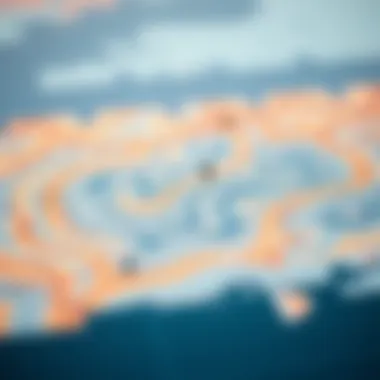
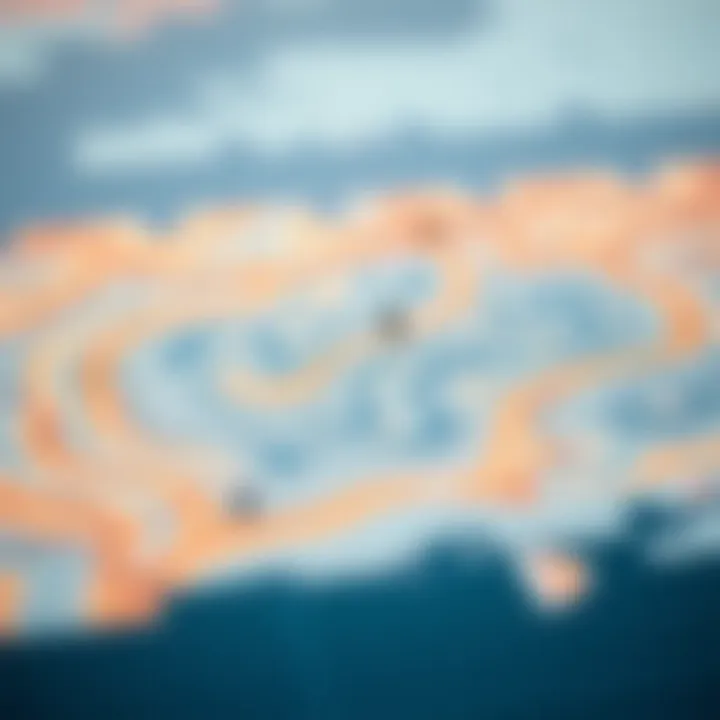
Intro
Kiteboarding is not just a sport; it's an exhilarating dance with the wind. The wind map plays a pivotal role in this engaging activity. It showcases how wind currents travel over the water, affecting all kiteboarders whether they’re gliding across calm bays or tackling choppy waves. For those keen to master kiteboarding, understanding the wind map is not merely beneficial; it’s essential.
The intricacies of wind patterns can enhance your ride, allowing for better control and more thrilling maneuvers. From learning how to read wind speed to recognizing differing atmospheric pressures, this guide aims to equip you with knowledge and strategies tailored to both novice and experienced kiteboarders. By the end, you should feel more confident in using wind maps and adapting to nature’s whims while engaging in this outdoor adventure.
Gear and Equipment
Essential Kiteboarding Gear for Beginners
Starting out in kiteboarding requires the right equipment to ensure safety and enjoyment. Here’s a rundown of the essentials:
- Kite: The heart of kiteboarding. Beginner models like the Cabrinha Switchblade or the Naish Torch are not only forgiving but also versatile.
- Board: Choose a board like the Slingshot Misfit, which offers stability and ease for newcomers.
- Harness: This vital piece connects you to the kite. Opt for a waist harness for a good mix of support and freedom.
- Safety Gear: Don’t overlook a helmet and impact vest. They are critical for protecting against unexpected falls.
As you acquire experience, the right gear will make all the difference in your performance and confidence.
Advanced Equipment for Experienced Riders
Once you’ve found your footing, advancing your equipment can take your kiteboarding skills up a notch. Here’s what seasoned riders might consider:
- Foil Kites: These kites glide smoothly through the air and are ideal for light wind conditions. The Ozone Edge is a popular choice.
- Directional Boards: For those wishing to tackle waves, a board like the Liquid Force Wow can optimize your performance on water.
- Advanced Harnesses: Look into seat harnesses or specialty designs that offer more comfort and ease of movement during tricks.
Arming yourself with the right gear will not just improve your skills; it’ll instill a confidence that makes every ride more enjoyable.
Techniques and Tips
Safety Practices for Kiteboarding
With the thrill of kiteboarding comes the responsibility to prioritize safety. Here are some crucial practices:
- Know the Environment: Assess the launch site for potential hazards like rocks, currents, or other surfers. Local kiteboarding communities often have valuable insights to share.
- Use the Buddy System: Always ride with a partner to ensure backup in case of emergencies.
- Understand Wind Conditions: Stay updated on local wind reports from websites like Windfinder or Windy. Wind patterns can change rapidly.
- Practice Emergency Procedures: Knowing how to self-rescue or deploy your safety system can save your life in critical situations.
"Preparation and awareness are your best partners on the water. Kiteboarding should be thrilling, not terrifying."
Training Techniques to Improve Your Skills
Sharpening your kiteboarding skills involves more than just practice; it requires a thoughtful approach. Here are some tips to consider:
- Take Classes: Enrolling in local kiteboarding lessons can dramatically improve your technique. Experienced instructors provide avenues for constructive feedback.
- Drills: Set aside time to practice specific maneuvers repetitively—like jibes and jumps. Focused practice helps solidify skills effectively.
- Study the Wind Map: Regularly check your local wind map to learn how to adapt your techniques based on varying conditions. Understanding this can turn potential struggles into opportunities for improvement.
The journey of kiteboarding is filled with ups and downs. Familiarity with the wind and having the right tools at your disposal enables you to navigate this adventure with confidence.
Prelims to Wind Maps
In the world of kiteboarding, understanding wind maps can make the difference between a thrilling ride and a disappointing outing. For kiteboarders, whether novices or seasoned pros, these maps serve as essential tools in selecting when and where to sail. By interpreting the wind's behavior, enthusiasts can maximize performance and, equally importantly, enhance safety during their sessions.
Definition and Importance
Wind maps visually depict the patterns and movements of air across a region, incorporating crucial elements like wind direction and speed. These indicators are vital for kiteboarders, who rely on favorable conditions to achieve their best performance on water. The essence of a wind map lies in its ability to convey real-time data that kiteboarders can act upon. Imagine prepping your gear, only to realize that gusty winds are about to sweep through—having access to a well-informed wind map could save time and disappointment.
The importance of these maps extends beyond mere navigation; they help in making strategic decisions that directly influence one's kiteboarding experience. Kiteboarders can gauge the risks of potential weather changes, which allows for better planning. This aspect is particularly essential as ignoring wind patterns can lead to perilous conditions, including sudden squalls or unpredictable gusts. Thus, wind maps not only enhance performance but also play a crucial role in rider safety.
History of Wind Mapping
The journey of wind mapping can be traced back centuries. Early versions included simple directional charts drawn by navigators sailing uncharted waters who relied on the prevailing wind conditions to find their way. Over time, with advancements in meteorology, mapping methods evolved significantly. By the 20th century, the advent of technology, namely satellites and radar, allowed for a more sophisticated understanding of atmospheric behaviors.
The modern wind maps that kiteboarders utilize have roots in this historical evolution. Today's digital tools represent real-time data collected from buoys, weather stations, and even personal tracking devices. Such technology not only brings historical wind data but also predicts future patterns, giving kiteboarders a powerful edge when planning their activities.
As advancements continue, the tools available will grow even more intricate, offering insights refined by algorithms and high-tech sensors. The foundation built by early wind mapping has paved the way for the resources kiteboarders have at their fingertips today, allowing for a greater appreciation of the skies and winds that propel their passion.
Types of Wind Maps
Understanding the various types of wind maps is essential for kiteboarders aiming to make informed choices about when and where to ride. Each type of wind map serves a unique purpose, offering different benefits based on your needs and location. Whether you are a seasoned rider or just starting out, comprehending these distinctions will aid you in harnessing the wind more effectively during your sessions.
Static Wind Maps
Static wind maps are traditional and straightforward visualizations of wind patterns, focusing primarily on average wind speed and direction over a given area. These maps are often generated based on long-term meteorological data, making them useful for understanding prevalent wind conditions at specific locations.
One of the main benefits of static wind maps is their reliability. Since they are built upon historical data, they provide a foundational understanding of a location’s wind behavior. However, it’s crucial to remember that they may not reflect real-time conditions. For kiteboarders, this means that while static maps can indicate the generally favorable days or locations for wind sports, they should be cross-referenced with live data to make keen decisions.
- Key Points about Static Wind Maps:
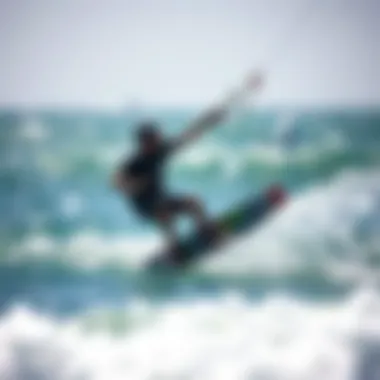
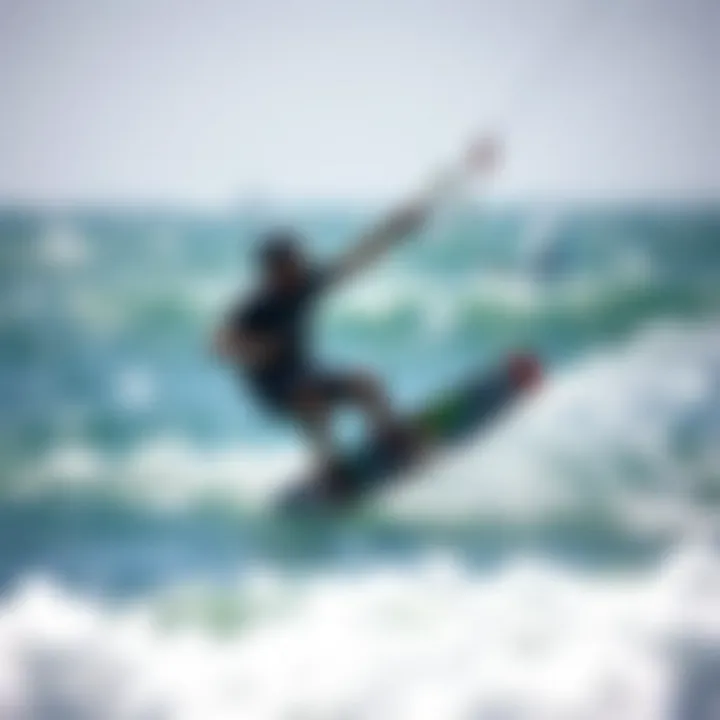
- Good for understanding seasonal trends.
- Helpful for planning trips to new locations.
- May miss sudden wind shifts or localized phenomena.
Static maps serve as a good starting point but should not be your only resource.
Dynamic Wind Maps
Unlike their static counterparts, dynamic wind maps are a game changer for real-time decision-making. These maps use sophisticated models that take into account changing weather patterns, presenting live updates on wind conditions. They often include color-coded wind speeds and arrows denoting direction, making it easy for users to assess the current situation at a glance.
For kiteboarders, dynamic maps are particularly beneficial. Imagine preparing for a session, only to find out moments before that conditions have dramatically shifted. Having access to dynamic wind maps can save you from wasted time and ensure you only head out when conditions are ideal.
- Notable Features of Dynamic Wind Maps:
- Live wind speed and direction updates.
- Useful for short-term planning.
- Can help avoid dangerous wind conditions.
In short, dynamic maps keep you in the know, offering a real-world snapshot and reducing the guesswork.
Interactive Wind Maps
Interactive wind maps take wind observation a step further by allowing users to engage with the data directly. These platforms often let users zoom in on specific areas, adjust filters for various types of data visualizations, and even set notifications for specific wind events. Users can click on locations to see historical data, forecasts, and graphical representations of wind patterns.
These maps empower kiteboarders by giving them control over the information they access. For someone planning a trip, an interactive map can facilitate a deeper dive into specific locations, showing how the wind shifts throughout a day, for instance, or how different geographical features may influence wind behavior.
- Advantages of Interactive Wind Maps:
- Personalized data exploration.
- Tailored insights based on geographical features.
- Enhanced understanding through visual engagement.
In the context of kiteboarding, this level of detail can be the key difference between an enjoyable ride and a challenging one, making interactive maps an indispensable resource.
As you consider which type of wind map best suits your needs, remember that the combination of these various tools can equip you better for the sport. For resources and platforms to access these maps, you can check sites like Windy.com or Weather.com. Each type has its particular strengths, and understanding these differences will undoubtedly lead to improved kiteboarding experiences.
Components of a Wind Map
When it comes to kiteboarding, wind maps are your bread and butter. Understanding the components of a wind map lays the groundwork for smart decisions out on the water. Each element works in harmony to bring clarity to what can often be an unpredictable outdoor environment. Let’s break it down into the essential aspects that kiteboarders need to know.
Wind Direction Indicators
To catch the wind just right, it’s vital to know its direction. Wind direction indicators on a map can take many forms, such as arrows or compass roses. These represent the point from which the wind is blowing, not where it’s heading. For instance, if you see an arrow pointing north, that means the wind is coming down from the north.
Knowing the wind direction is critical for kiteboarding. Different spots along a coastline can behave quite differently based on how the wind flows over them. Moreover, location-specific factors like terrain or buildings can redirect the wind, leading to unexpected changes in conditions. By having a grasp on these indicators, you’ll be more prepared to pick the best launch point, avoid sudden gusts, and maintain control of your kite.
Wind Speed Measurements
Wind speed is another key player in kiteboarding dynamics. These measurements are often displayed in knots or miles per hour on wind maps. On a calm day, you might find speeds around 5 knots, which is hardly enough to get your kite airborne. Meanwhile, strong winds of 20 knots or more could spell excitement and potential risks.
The variability of wind speed can lead to major differences in your kiteboarding experience. Thus, it’s essential to look not just at the average speed but also how the wind might fluctuate throughout the day or in different locations on your map. Keep in mind that apps and sites may provide real-time data, which is a lifesaver when you're trying to predict sudden changes in conditions.
Geographical Considerations
Geography has a sneaky way of influencing wind patterns. When interpreting a wind map, it’s crucial to account for the local landscape. Mountains, valleys, and beaches can all play significant roles in how wind behaves. Wind tends to gain speed as it funnels through narrow spaces, such as a gap between hills, while also swirling unpredictably over water bodies.
Moreover, coastal features can create zones of varying wind intensity. For example, a beach with a broad expanse of open water might see steady onshore winds, while a cove could experience stronger gusts due to the topography. Recognizing these geographical intricacies will help you choose safer and more thrilling kiteboarding locations.
In summary, the components of a wind map—directions, speeds, and geographical influences—aren’t just numbers or symbols; they're the language of the wind. Understanding these elements allows kiteboarders to navigate effectively, ensuring a day on the water brimming with both exhilaration and safety.
"A well-read wind map is like a kiteboarder's compass, guiding you through the winds of opportunity and caution."
For further reading on geographical factors affecting wind, check out National Weather Service or Atlas Obscura.
How to Read Wind Maps
Reading wind maps is an essential skill for kiteboarding enthusiasts, as it allows riders to decipher patterns that directly impact their performance and safety. A clear understanding of wind maps enables kiteboarders to make calculated decisions regarding their choice of location, the timing of their sessions, and the type of gear they should use. With shifting winds playing a key role in the kiteboarding experience, being adept at interpreting wind data can dramatically enhance one’s enjoyment and safety on the water.
Understanding Symbols and Notations
Wind maps often present a variety of symbols and notations that can seem overwhelming at first glance. However, by familiarizing yourself with these indicators, you’ll be able to read the maps like an expert in no time. Most wind maps use arrows to represent wind direction. The direction in which the arrow points indicates where the wind is coming from. For instance, an arrow pointing north signifies a wind blowing south.
Alongside arrows, you'll often find color codes corresponding to wind speeds. For instance, shades of blue might indicate lighter winds, while vibrant reds could signal stronger gusts. Understanding these color gradients is crucial; it can inform whether you should rig your larger kite for a boisterous day or a smaller one for mild breezes.
In some cases, the maps employ numerical values next to arrows or within colored fields to indicate wind speed in miles per hour or knots. Additionally, contour lines might appear, illustrating pressure systems that affect local wind behavior. This level of understanding allows kiteboarders to predict how conditions might shift throughout the day.
Analyzing Wind Patterns
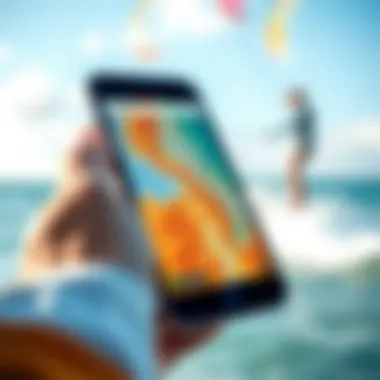
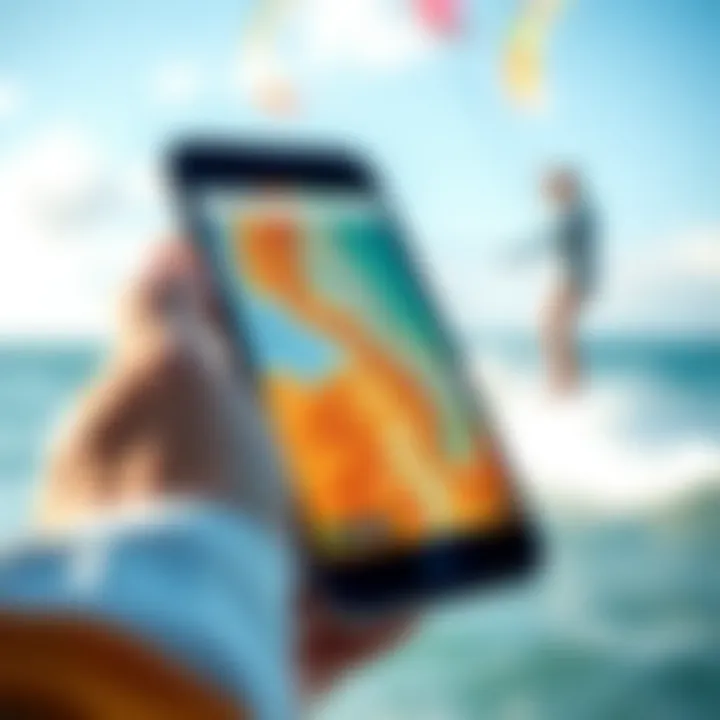
Once you're familiar with the basic symbols and notations, the next step is to analyze wind patterns. This is where the magic happens; recognizing patterns can be the difference between an exhilarating session and unproductive struggling. Wind patterns can be influenced by various geographical features like hills, trees, or buildings.
One effective way to analyze these patterns is to pay attention to how the wind behaves in different areas, especially if you frequent a particular spot. For example:
- Localized Gusts: Areas with trees may funnel winds, creating gusty conditions that can be unpredictable.
- Consistent Breezes: Beaches with open water often experience steadier winds, which allows for more reliable kiteboarding experiences.
- Thermal Winds: These are generated by solar heating, often leading to stronger mid-afternoon winds.
Furthermore, look at historical data if available; some online platforms provide archives of wind speeds and directions over time. Understanding past trends can help forecast wind conditions for your next outing.
By learning to read and analyze wind maps effectively, kiteboarders can embrace optimal riding conditions, all while remaining aware of potential hazards.
Through this continuous learning and observation, you will enhance not only your kiteboarding skills but also ensure a safer and more engaged experience on the water.
Wind Maps in Kiteboarding
Understanding wind maps is essential for kiteboarding enthusiasts. These tools provide key insights into how wind patterns influence riding conditions and, ultimately, performance. By effectively utilizing wind maps, kiteboarders can enhance their experience on the water and navigate various environments with confidence.
Optimizing Performance with Wind Data
Wind maps offer a treasure trove of information that can be used to optimize performance on the water. When reading these maps, kiteboarders can determine the strength and direction of the wind, helping them select the right gear and techniques. For instance, a strong crosswind might favor larger kites, while light, onshore winds could necessitate a different approach.
When it comes to enhancing performance, the strategic use of wind data is paramount:
- Gear Selection: Knowing the wind speed can guide you in choosing the right kite size. A common rule of thumb is that lighter winds require larger kites, while stronger winds call for smaller sizes.
- Technique Adjustment: Understanding wind patterns can influence stance and speed. Navigating in headwinds requires a different technique than riding downwind; having that knowledge in advance makes a big difference.
- Location Awareness: Some spots are notorious for their tricky wind conditions. Using wind maps helps kiteboarders avoid those areas where wind might shift unexpectedly.
Safety Considerations
Safety is another critical aspect influenced by wind maps. Kiteboarding can be thrilling, but it comes with inherent risks, especially in unpredictable wind conditions. Having the ability to read and interpret wind maps plays a pivotal role in ensuring that safety measures are fully in place:
- Preventing Overexcitement: An overly optimistic reading of wind conditions can lead to risking it all. A kiteboarder should always cross-reference wind maps with real-time observations to avoid dangerous situations.
- Awareness of Wind Shifts: Wind can change rapidly, leading to inexperienced kiteboarders getting into trouble. Familiarity with wind maps and their predictive capabilities equips a rider to respond to sudden shifts or gusts.
- Rescue Plan: Knowing where to launch, land, and seek assistance based on prevailing winds can be the difference between a great ride and a perilous situation.
"Being aware of wind conditions ahead of time helps kiteboarders stay safe and enjoy their time on the water."
Choosing the Right Time and Place
Wind maps also guide kiteboarders in selecting the most favorable time and location for their activities. Certain times of the day can bring more reliable winds, while weather patterns shift throughout the week:
- Time of Day: Early mornings or late afternoons often offer steadier winds. Those who understand the patterns might show up at prime times to get the best conditions.
- Seasonal Variations: Different seasons bring distinct wind characteristics to various locations. Checking historical wind data from wind maps can help identify the optimal times of year for kiteboarding at specific spots.
- Geographical Features: Wind conditions are also affected by geographical features like trees and buildings. Riders who analyze wind maps in conjunction with a site’s layout can choose their spots wisely, avoiding areas that might create turbulence.
By integrating wind maps into their planning process, kiteboarding enthusiasts can not only elevate their performance but also ensure a safe and enjoyable experience on the water. Understanding winds is not merely a tool but a profound skill that can turn an average day into an unforgettable ride.
Tools and Resources for Kiteboarders
Kiteboarding is an exhilarating sport that demands not just skill but also an understanding of the environment. One of the cornerstones of this understanding lies in having the right tools and resources at your disposal. Whether you are a novice just dipping your toes into the sport or a seasoned rider, leveraging these tools can significantly enhance your experience and performance on the water. In this section, we will explore both online platforms and mobile applications that provide essential data and insights for kiteboarders, allowing for informed decision-making when it counts.
Online Platforms
When it comes to kiteboarding, having real-time access to wind conditions, tides, and weather forecasts is crucial. There are various online platforms that kiteboarders can utilize to gather this essential information. Websites like Windy (windy.com) and Weather Underground (wunderground.com) offer comprehensive data that helps kiteboarders plan their outings effectively.
- Windy: This platform provides wind maps with detailed real-time updates. Users can view wind speed, direction, and even visualize the changes over time. The interface is user-friendly, and it delivers accurate information, making it an essential tool for kiteboarders looking to catch the best winds.
- Weather Underground: A treasure trove for weather enthusiasts, this site enables users to access hyper-local forecasts. Knowing how weather patterns can shift in a matter of minutes can make the difference between a successful session and a day spent wishing you had stayed at home.
- Kiteboarding International: Their community-sharing aspect includes forums where seasoned kiteboarders share insights and tips, which can be invaluable for both learning and connecting with fellow enthusiasts.
Online resources not only provide valuable information, they also foster a community. Engaging in forums or discussion boards helps riders connect and share firsthand experiences about specific spots or conditions.
Mobile Applications
In an era where information is just a tap away, mobile applications have emerged as indispensable tools for kiteboarders. Being out on the water means having immediate access to forecasts and wind maps right at your fingertips. Some standout applications include:
- KiteMate: This app specializes in tracking wind conditions and offering insights into local spots. KiteMate's user-friendly interface allows you to quickly gauge whether the conditions are favorable for riding.
- Windfinder: This app is like carrying a weather station in your pocket. It provides current wind speeds and forecasts for numerous locations around the world. A useful feature is its notifications alerting you when the wind conditions meet your preferences.
- Surfline: Although primarily known for its surf predictions, Surfline also includes wind data. It connects with local cameras, giving you a visual on how the conditions are shaping up — all ideal for making real-time decisions.
Overall, mobile applications serve as a lifeline, keeping you informed while on-the-go. They allow kiteboarders to make crucial decisions, ensuring safety and enjoyment during their adventures.
"The best kiteboarding sessions come from informed choices; tools and resources make those choices clearer."
Case Studies of Successful Wind Map Usage
Understanding how wind maps play a role in kiteboarding can greatly enhance a rider's performance and safety. By examining real-life examples, enthusiasts can glean insights that increase their awareness of wind patterns and improve their skills. This section showcases the importance of case studies in demonstrating effective wind map usage, showing how these experiences contribute to building a more informed kiteboarding community.
Professional Insights
When you look at professional kiteboarders, they often rely on wind data from their trusty maps to optimize their riding. Take, for instance, the case of Jesse Richman, a well-respected name in the kiteboarding world. He often discusses how he accesses wind maps before hitting the water. He believes that knowing the wind direction and speed can make or break a session. Since different types of kites perform better under varying conditions, aligning personal gear with wind data becomes imperative.
For instance, Jesse uses a combination of local wind data and several reputable online resources like Windfinder and MeteoBlue. By interpreting these maps, he strategically targets locations with favorable winds for his specific style, whether it’s freestyle or wave riding. This precision not only improves performance but also encourages safer practices among fellow riders.
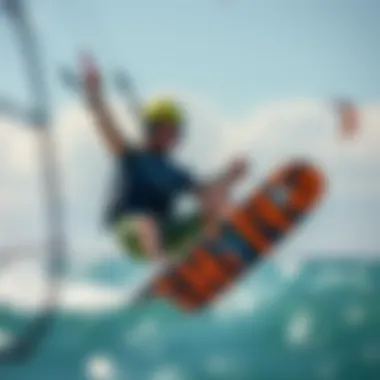
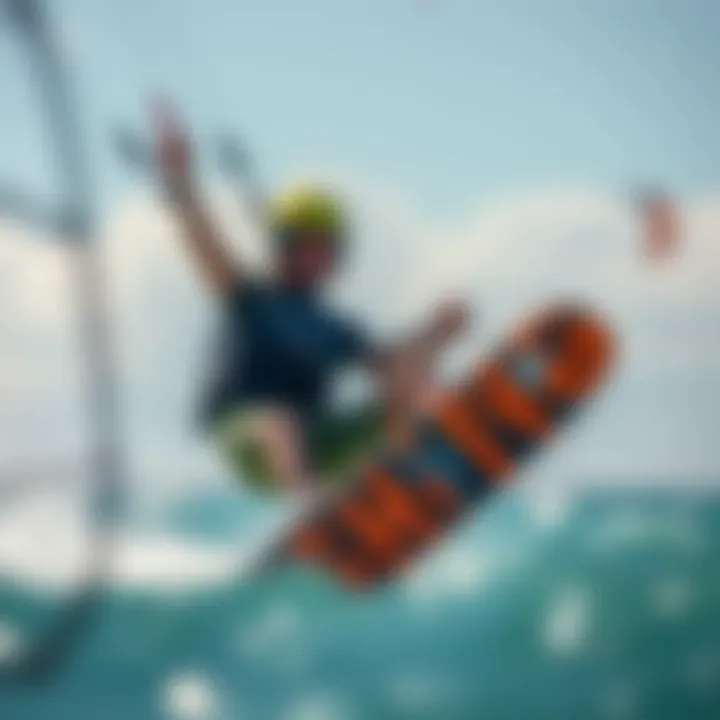
"The wind is like a dance partner. If you sync up with it, your ride becomes a symphony of control and thrill," Jesse often notes, emphasizing the essential nature of wind mapping in kiteboarding.
Another professional kiteboarder, Susi Mai, echoes similar sentiments. She highlights specific spots around Hatteras Island known for their shifting winds. Here, she often shares insights on how to read local conditions based on the regional wind maps, encouraging other riders to tap into the resources available. These pros provide invaluable learning opportunities through their experiences, showing the balance between skill and understanding environmental dynamics.
Local Experiences
Local kiteboarding communities also have a treasure trove of experiences related to wind maps. In smaller communities along the Texas coast, for example, kiteboarders often gather for informal meetups. During these events, they share tips on using wind maps effectively for different kiteboarding seasons, thus enriching the collective knowledge.
One prominent local kiteboarding group operates around South Padre Island, easily accessible for riders of all skill levels. They frequently refer to wind maps to determine the best launch sites based on hourly forecasts. When strong thermals kick in during the afternoon, the local veterans guide newcomers on adjusting their strategies to maximize fun and safety. These interactions foster a sense of camaraderie and cultivate a deeper understanding of shared resources.
The group’s Facebook page includes updates about wind conditions, along with images of various setups tailored for the local wind patterns. This kind of grassroots sharing not only enhances everyone's skills but also deepens the sense of community that defines kiteboarding culture.
In summary, professional insights combined with local experiences help to substantiate the value of wind mapping. By looking at real-life examples, we see just how invaluable these tools can be for both skilled riders and newcomers eager to learn. Harnessing this data can dramatically improve the kiteboarding experience, making it not only safer but also significantly more enjoyable.
Challenges and Limitations
In the world of kiteboarding, the wind is the lifeblood of the sport. However, harnessing its power can come with its own set of challenges. Understanding these limitations is crucial for kiteboarders who want to elevate their skills and ensure a safe experience on the water. Whether you're a weekend warrior or a seasoned pro, you must comprehend the potential pitfalls that come with wind maps and how they affect your outing.
Interpretation Issues
Wind maps are often laden with symbols and indicators that can be jarring, especially for newcomers. These maps, designed for convenience, might not always translate well into actual conditions. For instance, a certain wind speed marked might not account for local terrain variances or sudden changes in weather patterns. A kiteboarder might look at a map and see a green zone, indicating a steady breeze, but what if there's a cliff nearby creating gusts?
Misinterpretation can lead to a false sense of security. The maps might suggest favorable conditions, yet the reality is filled with chaos. Familiarizing oneself with how to interpret these symbols correctly and understanding the context of local geography is imperative. Here are some points to keep in mind regarding interpretation:
- Local Factors: Always consider local obstacles, like buildings or trees, that can create unpredictable wind gusts.
- Real-time Updates: Conditions can change quickly; thus, check for the most recent data before heading out.
- Experience Matters: Sometimes, intuition and experience may trump what the wind map shows.
Wind patterns are not set in stone. Being flexible and prepared for on-the-spot changes can be your best ally.
Data Reliability
Another pressing concern with wind maps is the reliability of the data. Not all sources provide equitably accurate information. For example, different platforms might use varying methodologies or technologies to gauge wind conditions, leading one to paint a misleading picture of what awaits at the beach.
Consider these aspects when evaluating data reliability:
- Source Trustworthiness: Rely on established meteorological services or proven kiteboarding applications rather than random websites.
- Usage of Predictive Models: Many platforms rely on historical data to predict future conditions, but these can be prone to errors due to unforeseen variables.
- Crowdsourced Data: In some cases, platforms allow users to report their wind experiences. This can provide real-time insights but may also lack consistency in reporting methods.
In short, while wind maps are an irreplaceable tool for kiteboarding, recognizing their limitations can save a kiteboarder's day. Bolstering your knowledge with these considerations ensures that you navigate smoothly over waves and avoid unnecessary mishaps that come from misinterpretation or unreliable data.
Future of Wind Mapping Technologies
Wind mapping technologies are evolving, creating not just opportunities for kiteboarding enthusiasts but also elevating the entire realm of outdoor sports. Understanding how these advancements can influence kiteboarding experiences is vital for both safety and performance. With the integration of technology, kiteboarders can access real-time data, navigate diverse environments, and ensure they are always riding the winds at their best.
Innovative Developments
The innovations in wind mapping tech are nothing short of exciting. One such development is the use of drones equipped with anemometers. These flying devices can gather wind data from various altitudes, offering an unprecedented view of wind conditions. This means kiteboarders can receive updates tailored to specific locations, unlike previous methods that only provided generalized forecasts.
Another noteworthy advancement is the incorporation of machine learning algorithms into wind prediction models. By analyzing historical data alongside current weather patterns, these systems can forecast conditions with remarkable accuracy. Kiteboarders can harness this information to select better times and locations for their rides. It’s like having a crystal ball for wind conditions.
Moreover, wearables are joining the fray. Devices like smartwatches and augmented reality goggles are being designed to provide instant wind data. Imagine having essential stats at your fingertips while gliding over the waves! This real-time feedback can refine techniques and improve performance.
Potential Impact on Kiteboarding
The potential impact of these technologies on kiteboarding cannot be overstated. With enhanced forecasting capabilities, kiteboarders can make decisions founded on data rather than gut feelings. This not only elevates performance but also significantly improves safety.
- Enhanced Safety: With accurate predictions, riders can avoid dangerous conditions like unexpected gusts or shifts in wind direction. Knowing when to hit the water and when to stay reserved can make all the difference.
- Performance Optimization: Better wind data allows kiteboarders to refine their skills. Riders can analyze where and when they perform at their peak, iterating on techniques under optimal wind conditions.
- Wide Accessibility: As more tools become available, even novice kiteboarders will pick up knowledge about wind patterns—allowing them to grow into the sport more confidently.
Wind mapping isn't merely a technical advancement; it's a bridge connecting kiteboarders to more informed, enjoyable, and safer experiences. With this foundation, enthusiasts stand to surf the winds with a sharper edge, blending technology and thrill seamlessly.
"The future is all about harnessing the wind not just through skill, but through superior understanding and technology."
The End
In the realm of kiteboarding, understanding wind maps is not merely an academic exercise; it's a fundamental component of the sport. The conclusions drawn in this article emphasize the critical relationship between wind patterns and kiteboarding performance. Knowing how to analyze these maps can mean the difference between a thrilling adventure and a challenging outing.
Summary of Key Points
- Importance of Wind Knowledge: Kiteboarders must be equipped with the ability to read wind maps to optimize time on the water. Wind direction and speed significantly affect the overall experience, enhancing both safety and performance.
- Types of Wind Maps: Remember, not all wind maps are created equal. Familiarity with static, dynamic, and interactive maps will serve you well. Each type offers unique insights suitable for different circumstances and environments.
- Tools and Resources: Online platforms and mobile apps play a pivotal role in providing real-time data. Kiteboarders who leverage these resources can make informed decisions about when and where to kite, potentially avoiding unfavorable conditions.
- Safety and Performance: Safety should always be a kiteboarder's top priority. Being aware of changing wind patterns can help avoid risky situations. Moreover, a deeper understanding of wind dynamics can lead to better maneuvers and improved performance.
Final Thoughts on Wind Maps and Kiteboarding
In wrapping up, we have explored the nuances of wind mapping, uncovering how it directly influences the kiteboarding experience. For both novice and seasoned kiteboarders, mastering wind maps provides not just an edge in performance but also enhances safety—two critical aspects of enjoying the sport fully. Whether you're riding the waves at your local beach or venturing into more challenging conditions, making wind maps a staple in your preparation can elevate your kiteboarding journey to new heights. As technology advances, staying knowledgeable about emerging mapping solutions will only enrich your adventures.
"A gust of wind can change everything—stay prepared!"
For further reading on kiteboarding and wind conditions, you might find these resources useful:
- Wikipedia on Kiteboarding
- Britannica's Overview
- Various kiteboarding discussions on Reddit
- Local wind conditions via government resources like weather.gov
- Community insights on Facebook groups centered around kiteboarding.



